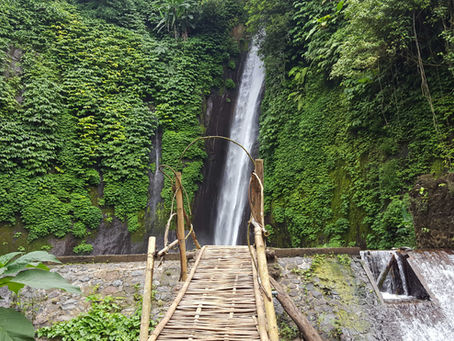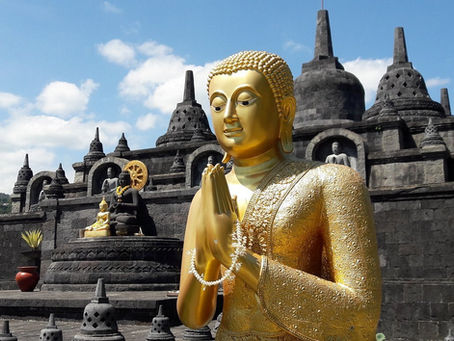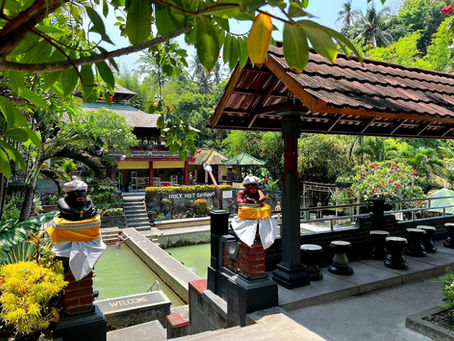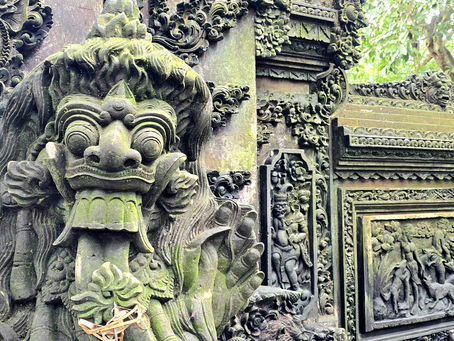top of page

GLOBAL SHANANIGANS

Search


Munduk Waterfall
Flowing through Bali’s northern highlands, Munduk Waterfall is more than a natural wonder. Surrounded by forests, clove plantations and jungle cliffs, it is a sacred site where guardian spirits dwell and restless souls are said to linger. Visitors come not only for its refreshing pools but to feel the ancient energy that makes the place alive, watchful and transformative.
Shannon


Batukaru Temple
High on the slopes of Mount Batukaru, Pura Luhur Batukaru is a sacred temple dedicated to Mahadeva, Bali’s fierce and protective God of nature. Moss covered meru towers rise above sacred springs and the air seems charged with centuries of devotion. The temple bears the memory of a violent battle that once shook its grounds, while legends of unseen guardians and lingering spirits continue to echo through its courtyards, giving Batukaru an enduring aura of mystery and sacred po
Shannon


Bale Kambang
Floating within the ruins of Klungkung Palace, Bale Kambang rises like a defiant island, a silent witness to centuries of ambition, devotion and blood soaked politics. Built when Bali’s unified kingdom splintered into warring courts, it is more than a royal relic, a fusion of power, spirituality and symbolic mastery. Its ceiling murals depict kings and gods walking the line between the mortal and the divine, while the surrounding waters reflect the cosmic ocean and the fragil
Shannon


Brahmavihara Arama Buddhist Monastery
Perched 300 meters above Northern Bali’s hills, Brahmavihara Arama is the island’s largest Buddhist monastery, offering breathtaking views over rice terraces and the Bali Sea. Though built in the 1970s, this tranquil sanctuary has quickly become a must-visit spiritual retreat away from the usual tourist paths.
Shannon


Banjar Holy Hot Springs
Believed to have been used for nearly a thousand years, the Banjar Hot Springs, known locally as Permadian Air Panas, hold deep spiritual and cultural significance dating back to at least the 10th century. Oral traditions and local belief suggest these sacred springs have long served as a place for ritual purification and healing, well before the arrival of modern tourism.
Shannon


Kerta Gosa Pavilion
Steeped in centuries of judgement, where kings and nobles once wielded verdicts beneath the watchful gaze of the gods, Kerta Gosa stands as a chilling testament to Bali’s intertwining of law, ritual and cosmic retribution, a sacred space where punishment was vivid, divine, and absolute. Beneath the flaking frescoes that depict the torments of the underworld, the echoes of those rulings linger like a cold breath, a haunting reminder that justice here was relentless and inescap
Shannon


Alas Harum Bali
In Tegallalang valley, Alas Harum lures Instagrammers to sky-high swings and rope bridges, yet farmers continue cultivating rice as they have for generations. The hillside cascades in green steps, forming a living landscape that is both a visual spectacle and a functioning agricultural system. Even amid the crowds, the valley’s heartbeat remains in the careful balance of water, labour and tradition that sustains its cultural and natural heritage.
Shannon


Tanah Lot - Bali’s Famous Sea Temple
One of Bali’s most revered and iconic sea temples, perched on a rocky outcrop along the island’s west coast, is Tanah Lot. Set about 300 metres offshore, the shrine faces the unyielding tides of the Indian Ocean, its striking presence blending natural drama with deep spiritual meaning. Though calm and picturesque from afar, the temple is regarded as a threshold where divine forces are worshipped and balance is maintained against darker energies.
Shannon


Klungkung Royal Palace
Rising from the legacy of the Gelgel kingdom and the distant glory of the Majapahit Empire, Klungkung Palace was built in 1686 as the proud heart of a fractured Bali. For centuries it stood as a symbol of royal prestige, until 1908, when Dutch fire and a blood soaked Puputan reduced its grandeur to ruin, leaving only whispers of power, betrayal and the ghosts of a kingdom that refused to kneel.
Shannon


Sacred Flames - Ubud’s Cremation Temple
Perched on the shadowed fringe of Ubud’s Sacred Monkey Forest, Pura Prajapati stands as a silent witness to centuries of life, death and the thin veil between them. Built around 1350AD, this moss cloaked cremation temple is one of the forest’s three ancient sanctuaries, yet its presence carries a weight far beyond stone and mortar.
Shannon


The Telaga Waja River
The Telaga Waja River, flowing down the verdant slopes of Mount Agung in East Bali, is best known today for its rafting adventures but beneath its rushing waters lies a deep, often overlooked historical and cultural undercurrent. Historically, this river has served as both a geographical and spiritual artery for the people of Karangasem. It provides water for rice fields through a traditional irrigation system called subak and many Balinese believe it to be sacred.
Shannon


Goa Gajah Temple
Mystery surrounds the true origins of Goa Gajah, a 9th century cave temple complex near Ubud in central Bali. Rediscovered by Dutch archaeologists in 1923 after centuries hidden beneath dense vegetation, the site holds no actual link to elephants, despite its name. The term “Elephant Cave” likely evolved from Lwa Gajah, an old name associated with the nearby river, not from any animal symbolism found within the temple itself.
Shannon


The Sacred Nāgas of Bali - Guardians of the Island
In the mystical landscape of Bali, where volcanoes brood above emerald rice terraces and the sea whispers ancient secrets, serpentine beings known as Nāgas hold a revered place in the island’s cosmology. These mythical serpent deities, often depicted as long, dragon-like creatures adorned with golden crowns and shimmering scales of green and gold, are considered powerful protectors of water, fertility and the spiritual balance between the underworld, earth and the heavens.
Shannon


In the Shadow of Agung - Sidemen’s Sacred Legacy
Tucked into the emerald folds of eastern Bali, Sidemen is a village preserved in time, its quiet beauty masking layers of history, mysticism & ancient power. Long before it became a retreat for travellers, Sidemen was the cradle of sacred agricultural rituals & spiritual learning. Oral traditions trace the village’s origins back to Bali’s earliest kingdoms, once a training ground for priests drawn to the area's potent energy and its proximity to Mount Agung, the island’s most
Shannon


Queen of Demons - The Legend of Rangda
Evoking both fear and intrigue, the Balinese divinity known as Rangda stands as a terrifying yet essential force within the island's spiritual and cultural landscape. She is more than just a monstrous figure, she is the embodiment of ultimate darkness, chaos and destruction, the shadow side of the cosmos that cannot be ignored or denied.
Shannon


Kajeng Rice Fields Loop
Slicing through glittering, gently terraced rice fields and fringed by towering coconut palms, the Kajeng Rice Fields Walk is arguably one of the prettiest treks you can do in the cultural capital of Ubud without a guide. Kajeng offers a rare and intimate glimpse into Bali’s traditional agricultural life, set against a landscape that’s both serene and alive with quiet purpose.
Shannon


The Ogoh Ogoh Museum of Demons
Each March, as Bali prepares for the eerie silence of Nyepi, grotesque effigies of demons and witches are paraded through the streets before being set aflame. Yet not all are consigned to fire, some escape their ritual death and find a resting place in the Ogoh Ogoh Museum, a shadowy graveyard of towering statues where the spirits of chaos seem forever frozen in time.
Shannon


Sangeh Monkey Forest
Sprawled across 14 hectares of ancient forestland, Sangeh Monkey Forest, also known as Obyek Wisata Bukit Sari Sangeh, is one of Bali’s most enchanting natural sanctuaries. Towering nutmeg trees, some reaching over 40 metres tall, dominate the landscape, creating a high green canopy that diffuses the tropical light and hushes the sounds of the outside world. But what truly sets this forest apart is its origin story. According to legend, the trees were not planted, they walked
Shannon


Barong - King of the Good Spirits
Barong is one of the most iconic and revered figures in Balinese mythology, embodying health, good fortune and divine protection. More than just a mythical creature, Barong is believed to act as a guardian angel, accompanying each person through life and shielding them from harm. He is the leader of the hosts of good and the eternal nemesis of Rangda, the dreaded Widow Queen.
Shannon


Gunung Kawi Sebatu - Mayadenawa's Curse
Gunung Kawi Sebatu is one of Bali’s lesser visited yet most serene temple complexes, nestled in the forested highlands of Sebatu village. Established during the 11th century, its origin is tied to the ruthless reign of King Mayadenawa, a figure known in Balinese lore for defying the gods. The temple is dedicated to Vishnu, the Hindu preserver deity and features crystal-clear spring pools, manicured gardens and a peaceful atmosphere that belies the legend tied to its sacred wa
Shannon
bottom of page